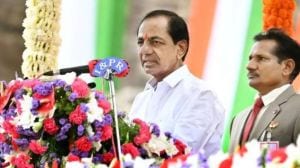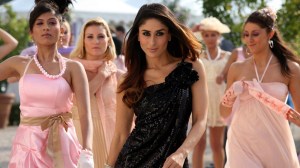Click here to follow Screen Digital on YouTube and stay updated with the latest from the world of cinema.
A Slice of Life: Sumitra Bhave turned a filmmaker because she wanted to share stories of struggle and survival
Filmmakers Sumitra Bhave and Sunil Sukhtankar talk about the industry imposed label of ‘social filmmakers’ and of cinema that enriches the mind.
 The perfect frame: Sumitra Bhave and Sunil Sukhtankar
The perfect frame: Sumitra Bhave and Sunil Sukhtankar
It seems surprising when Sumitra Bhave says she was neither a movie-buff nor intended to become a filmmaker till she was 40. The Pune-based director, one of the leading filmmakers of contemporary Indian cinema, began filming because she wanted to share stories of struggle and survival. While working on a research project during the early Eighties, Bhave, who taught at Pune’s Karve Institute of Social Service, recorded oral accounts of women of a local slum who overcame adversities by sheer determination. “Some of my respondents were illiterate women. So, we thought of an audio-video medium to share with them their stories,” she says.
She turned it into a docu-feature, Bai (1983). While shooting for the film, members of Anubhav, a Pune-based theatre group, became her assistants. Sunil Sukhtankar was one of them. “When we started screening Bai in slums, Sumitra-ji realised that cinema is a powerful medium. Her next, Paani, portrayed the struggle of women in a drought-prone area. It received a National Award,” says Sukhtankar, who, after assisting Bhave on her first few films, became her co-director in Eighties.
He joined the Film and Television Institute of India (FTII) from 1986-1989 to study direction.
From Bai to their latest, Kaasav (The Turtle), winner of the Swarna Kamal, (the 2017 National Award for Best Feature Film), Bhave, 75, and Sukhtankar, 50, have explored social, and occasionally philosophical subjects. Kaasav, their 15th film together, weaves the tale of two unlikely protagonists, and seamlessly juxtaposes the lead character’s efforts to conserve Olive Ridley turtles on the Konkan coast. A middle-aged woman (played by Irawati Harshe) grappling with depression, gives shelter to a youth (Alok Rajwade), who wants to end his life.
To hold a mirror to society and highlight the human condition without being pedantic, is not easy. And yet, it is something the two have managed to do in their previous films as well. Zindagi Zindabad (2000) gives a peek into the lives of HIV patients; the much-talked about Devrai (2004) was about a brilliant, yet eccentric man (Atul Kulkarni), diagnosed with schizophrenia; Nital (2006) highlights the stigma about vitiligo; Astu (2013) is about a man suffering from Alzheimer’s, who goes missing. According to Sukhtankar, while their audience accepts their work as another movie, the film industry and media have a proclivity to label their work as “social” dramas. Noted actor Mohan Agashe, who has produced Astu and Kaasav, says: “Other people have forgotten these stories.”
Even though they bagged several awards for their first film in 1983, Bhave and Sukhtankar made their first feature film, Doghi, in 1995. After watching Chakori (1993), their award-winning short film about a village girl trying to ride a bicycle, Ravi Gupta, the then managing director of NFDC, approached them to make a feature film. By then, Bhave had made nearly a dozen short films and documentaries with Sukhtankar, including Ekalavya and Samvad.
 A still from Kaasav, their latest award-winning film.
A still from Kaasav, their latest award-winning film.
Doghi was about two sisters from a poor family in a Maharashtra village and their fight against social stigma. It received three National Awards and 11 State Awards. “Marathi film industry embraced us and NFDC asked us to make another film,” says Bhave, who co-directed Vaastupurush, featuring Sadashiv Amrapurkar and Uttara Baokar, next. Fortunately for Bhave and Sukhtankar, finding producers was never a struggle. In fact, there have been occasions when they have had to decline commercial offers.
Bhave and Sukthankar’s style of storytelling is personal, poetic and philosophical. They exhibit a rare restraint, as the conflicts of their characters unravels at a gentle pace. The nature of their work is determined by their desire to remain true to the subject.
Over the years, Bhave and Sukthankar have worked out “some kind of division of labour”. “She writes the scripts and I write the songs. She works with art direction, editing and costumes,” says Sukthankar. They also shoot in a very intimate setting, and mostly with a cast and crew they are familiar with.
They are also experts at creating controlled drama, without heightened emotions and melodrama. During the making of Badha (2006), the story of a woman accused of practising witchcraft, when celebrated actor Amruta Subhash asked her: “What acting style do you want me to have?” Bhave’s replied: “Dhimmuh (None)”. However, she made Subhash spend time with a family from the shepherd’s community and observe their ways. Years later, when Bhave cast Subhash as the wife of a nomadic mahout from Karnataka in Astu, the actor was asked to learn Kannada.
After winning multiple prestigious awards — between them, Bhave and Sukthankar have received 13 individual National Awards — Bhave cannot quite understand why they are referred to as “Marathi filmmakers”. “I am an Indian filmmaker. I make movies in Marathi because it is my mother tongue and I understand this culture better,” she says.


Photos


- 01
- 02
- 03
- 04
- 05





























